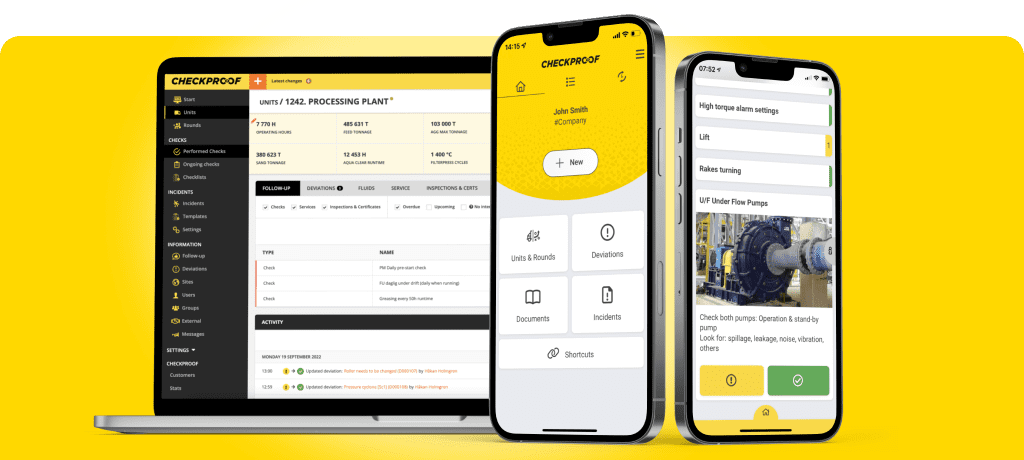By optimizing the utilization of your resources, your business can increase your operational efficiency, reduce your carbon footprint, and cut costs. This comprehensive article covers various aspects of resource optimization, primarily in a heavy industry context. You’ll learn about everything from the definition of common terms to the benefits of implementing digital technology in your frontline teams.
Table of contents:
- What is resource optimization?
- The importance of resource optimization in heavy industries
- Concepts in resource optimization
- Resource optimization across different business areas
- Industries and sectors benefiting from resource optimization
- Downtime reduction strategies
- Summary and future trends in resource optimization
What is resource optimization?
Resource optimization is a strategy aimed at obtaining the highest possible output or efficiency from your available resources. It’s about using your resources – be it manpower, raw materials, machinery, or financial capital – in the most effective way to achieve maximum value or productivity. Resource optimization covers a broad range of activities, from process streamlining and waste reduction to innovative use of resources and adopting state-of-the-art technology to maximize returns.
The importance of resource optimization in heavy industries
In heavy industry businesses, which tend to be resource-intensive, resource optimization is critical. Every bolt, unit of energy, and minute of an employee’s time, matters. For example, if your ready-mix concrete plant can shave even just seconds off your production process, or minimize waste by a few percentage points – the benefits, over time and volume, can be substantial.
3 reasons why resource optimization is crucial for your business:
1. Cost-efficiency
By optimizing your use of resources, your business can significantly cut down on costs. Reducing wastage, improving productivity, and enhancing resource utilization will all contribute to a healthier bottom line.
2. Competitive advantage
In a competitive market, customers will quickly go elsewhere if they think they can get faster delivery or better quality. By effectively managing your resources, your company can outperform rivals who don’t.
3. Sustainability
Today, sustainability is more than an ethical choice. It’s a business necessity. Efficient resource use limits your company’s negative impact on the local environment and reduces your CO2 emissions. This will, in turn, help you comply with environmental regulations – and improve the public’s view of your brand.
Concepts in resource optimization
Resource optimization comes with a variety of terms and concepts, each with its own perspective and strategies to improve an organization’s efficiency and productivity. Understanding these concepts will help you select and implement the best strategies for your particular business.
5 key concepts and their roles in resource optimization
1. PMO (Project Management Office)
The Project Management Office is the part of an organization that defines and maintains internal standards for project management. According to the Project Management Institute (PMI), the responsibilities of a PMO can range from providing project management support to being responsible for the direct management of a project.
By coordinating and managing resource allocation across different projects – ensuring minimum waste, maximum productivity, and alignment with strategic objectives – your PMO plays a crucial role in your company’s resource optimization.
2. Lean manufacturing principles
Originating from the Toyota Production System (TPS) developed in the 1950s and 60s, lean manufacturing aims to streamline processes and eliminate waste. Another term with a similar meaning is just-in-time (JIT) manufacturing.
Applying the five key principles of lean manufacturing (identify value, map value stream, create flow, establish a pull system, and pursue perfection) is an effective strategy for resource optimization.
3. Workforce optimization strategies
Workforce optimization (WFO) is about making the best possible use of your organization’s most valuable resource: your employees. Strategies include effective scheduling that matches workforce availability with demand, skills development to improve employee productivity, and methods for evaluating staff performance.
Pro tip: As a heavy industry employer, you can utilize digital technology to address some of the challenges connected to the ongoing generational shift in the workforce, such as skills shortage and key-person dependency.
4. Resource allocation techniques
Resource allocation means distributing the resources available to align with your organization’s goals. Techniques for this include prioritizing tasks based on importance and urgency, allocating the most suitable resource for each specific task, and using resource management software to automate allocation. Getting the allocation right reduces both over- and under-utilization of resources, which improves overall efficiency.
5. Resource planning
Resource planning involves forecasting your resource needs and planning ahead for how to utilize them efficiently. It helps your organization prepare for future demands, making sure the right resources are available when needed. By avoiding last-minute scrambles, resource planning leads to smoother operations and more successful optimization efforts in the long term. Tools for resource planning range from basic spreadsheets to complex software solutions.
Resource optimization across different business areas
Resource optimization provides significant benefits across various business functions. Let’s explore some different techniques and strategies within resource optimization and how they impact different areas of a business.
Energy resource optimization strategies
Optimizing energy use not only reduces costs but also contributes to a company’s sustainability efforts. Strategies include monitoring fuel consumption, implementing energy-efficient equipment, and promoting energy-conscious behaviors among employees – for example, through gamification.
Pro tip: By using digital tools that combine data monitoring with gamification elements, you can achieve lasting behavioral change among your frontline teams and reduce excessive idling across a diverse fleet of machines and vehicles.
Preventive resource maintenance
For a heavy industry business, preventive maintenance is an essential part of optimizing your resources. By adopting a proactive rather than reactive approach to asset maintenance, you can extend the lifespan of your equipment, avoid costly breakdowns, and ensure maximum productivity.
Pro tip: Want to learn more about what this approach looks like in practice? This article showcases three scenarios you can prevent with proactive maintenance.
Software solutions for resource optimization
From project management and supply chain planning to digital checklists for maintenance and HSEQ, software solutions can help your business automate and streamline your resource optimization efforts. When used correctly, these tools provide real-time visibility into resource utilization, support data-driven decision-making, and facilitate more efficient allocation and use of resources.
But with multiple data sources and information scattered across different platforms, it’s difficult to maintain an overview. Therefore, it’s important to set up a digital infrastructure where different applications can communicate with each other through APIs and integrations. This will enable you to combine information from multiple sources – for example, OEM telematics data, frontline deviation reports, and accounting systems – to obtain a 360 view of your operations.
Pro tip: Download the guide 9 keys to maximize the availability of your assets through frontline digitization for best practices on how to best leverage technology in a heavy industry business.
Supply chain optimization
The goal of efficient supply chain management is to ensure a company delivers its end-products to its customers at the lowest total cost with the highest possible profit margin. Throughout the supply chain – from raw material suppliers to manufacturing, storage, and distribution – businesses use different aspects of resource optimization to increase efficiency and reduce costs. This can involve improving inventory management, streamlining logistics, or enhancing supplier relationships.
In today’s global economy, supply chain optimization also needs to consider various risk factors that can disrupt the flow, such as political conflicts, pandemics, and the effects of climate change.
Industries and sectors benefiting from resource optimization
Using resources efficiently is, of course, key to businesses in any sector. But the impact is particularly pronounced in heavy industries, which are characterized by extensive use of physical resources and large workforces. Companies in sectors such as cement, concrete, aggregates, and asphalt, will therefore reap significant benefits through resource optimization strategies.
For instance, if you run an aggregate quarry, you can boost efficiency by optimizing the use of raw materials and energy, reducing both your production costs and environmental impact. And in cement production, you might improve your resource planning and allocation, allowing for streamlined processes and reduced downtime.
How mobile-first platforms enable frontline digitalization
By implementing digital technology not only in an office setting but also for your frontline teams, you can take your resource optimization strategies to the next level. Connecting field staff with office and management through applications allowing for two-way communication helps you continuously optimize your operations – including the use of resources – across your entire organization.
To succeed, you need to ensure the software and apps you chose are truly user-friendly and mobile-first. Otherwise, there’s a significant risk that frontline workers will be unable (or unwilling to) use them correctly – and you’ll miss out on valuable input from the field.
For example, CheckProof’s mobile-first platform helps several companies in various heavy industries to streamline their maintenance, HSE, and quality control through user-friendly checklists and deviation reporting. In addition, the app offers built-in integrations with numerous well-known OEMs. Companies using the app – among them Cemex UK, Preem, Jehander, and Swerock – are able to stream telematics data from connected equipment directly into CheckProof and combine this input with detailed logs from frontline workers. This enables real-time monitoring and management of resources, resulting in improved cost-efficiency, reduced waste, and enhanced safety.
“We’ve seen a steady year-on-year decrease in maintenance cost per produced metric ton since we started working with CheckProof. Between 2018 and 2021, this metric was reduced by 33%. We also see a decrease in the work hours spent on immediate corrective maintenance.”
Payman Namvar, Project Director, Swerock
Downtime reduction strategies
Excessive downtime hinders productivity and leads to significant financial losses, missed deadlines, and strained customer relationships. Therefore, downtime reduction is a strategic imperative for businesses aiming to maximize efficiency and productivity.
Importance of downtime reduction in resource optimization
Reducing downtime is vital to resource optimization. By minimizing unplanned downtime, your business can ensure resources such as machinery and labor are fully utilized, which will maximize efficiency and output.
Techniques to identify and minimize downtime in operations
Key techniques for downtime reduction include:
- proactive maintenance to prevent unexpected equipment failures
- using data analytics to identify patterns and predict potential downtime incidents
- training staff to quickly identify and rectify issues
An effective downtime reduction strategy uses a combination of these techniques to ensure operations run smoothly and efficiently.
Pro tip: In the article on how to reduce downtime in production facilities, you’ll find several hands-on tips, including keeping a downtime log and how to simplify frontline reporting.
Summary and future trends in resource optimization
Resource optimization is a strategic necessity for any heavy industry business looking to:
- maximize efficiency
- boost productivity
- improve cost efficiency
- reduce CO2 footprint
- get a competitive advantage
Established concepts within resource optimization include:
- PMO (Project Management Office)
- Lean manufacturing principles
- Workforce optimization strategies
- Resource allocation techniques
- Resource planning
Key components that contribute to successful resource optimization are:
- Effective supply chain management
- Monitoring of fuel consumption
- Preventive maintenance
- Downtime reduction strategies
Implementing software solutions, such as a mobile-first platform connecting frontline and office, can further enhance the results of resource optimization efforts.
Current and upcoming trends
Current trends in resource optimization include the use of data analytics to predict and prevent downtime and the increasing use of digital tools for resource management. Looking ahead, we can expect advances in technologies like AI and machine learning to further streamline resource optimization, offering even greater efficiencies and cost savings.
“With rising fuel prices and the impact of climate change, reducing excessive fuel consumption is at the top of the agenda for heavy industry businesses. We see a huge interest in using data and technology to optimize resource usage.”
Håkan Holmgren, CEO and co-founder, CheckProof
In conclusion, embracing resource optimization isn’t just a good business practice; it’s a strategic necessity for today’s competitive and sustainability-focused business environment.
Want to know what CheckProof can do for you?
CheckProof's easy-to-use app makes it easier to do the right thing at the right time. Discover how you can run world-class maintenance that is both cost-effective and sustainable.

Revolutionizing Compliance: Banner Contracts on managing ISO audits with CheckProof

Implementation of Digital Systems: Rolling Out CheckProof Across Teams

From Fuel Savings to Production Gains: Cemex Germany’s Wins with CheckProof

A Recap of the CheckProof Industry Event & 10th Anniversary Celebration

Trend Report: Key moments in the Construction Materials industry (2014–2024)

Meet Marcus Edlund, CheckProof’s First Employee and Tech Trailblazer

10 Key Technology Advancements in the Construction Materials Industries

SBMI’s Climate Roadmap for a Fossil-Free Aggregate Industry by 2045

HSEQ trends in the Construction Materials and Heavy Industry







